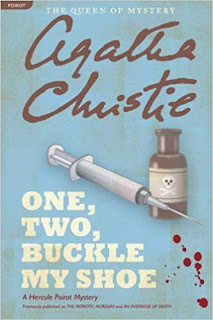Agatha Christie had a big controversy in her life itself. When her husband told her that he loved another and wanted to divorce her, she suddenly went missing for 10 days and was finally found booked in a hotel under the name of her husband's lover. There was relief when she was found, but there were also people who thought that this was a publicity stunt or maybe some way to implicate her husband in some conspiracy. These 10 days have never been really explained.
One, Two, Buckle My Shoe is another of those mysteries that are not so easy to pinpoint right in the beginning - I am sure that there will be few who will be able to peer through the mist and say, this person does it. You follow Poirot as he goes the case, with supreme confidence. It is a bit hard to look at the final set of guilty people and say, "Of course I knew these were the guilty ones". The story line does not involve too many people (I will provide a brief about the plot, but will hopefully not be revealing any spoilers - you should read the book or watch the TV version). If this is your first Poirot book, then you will wonder at his brilliance - if you have already these before, then you know that he will solve it, it is just the explanation that you are looking for as to how he figured out the guilty party.
Hercule Poirot comes back from a visit to the dentist, Henry Morley and meets the former actress Mabelle Sainsbury Seale, and in this encounter, he helps her with a buckle that has fallen from her shoe. Later in that day, his police friend, Inspector Japp tells him that the dentist he visited that day has been found dead, shot. Poirot is not a suspect, since there were more patients after Poirot before the dentist was found dead. There was a big name banker, Alistair Blunt, a person known as Amberiotis who is a Greek spy - he is later found dead of anaesthetic. There is a suspicion that the dentist killed himself because he killed Amberiotis in a medical mistake and felt horrible about it.
In a further twist, the dentist's secretary had been called away by a telegram, which was fake.
Soon after Mabelle goes missing, and is found later in the apartment of a lady, Mrs Albert Chapman, who is also not to be found. Now, it is upto Poirot to figure out what is happening, who killed the dentist and why the others were also killed. And of course, this being Hercule Poirot, he managed to find the truth. There is already a suspect, but is he the one who did the murders ?
The book was released under a couple of other names - "The Patriotic Murders" and "An overdose of death".






